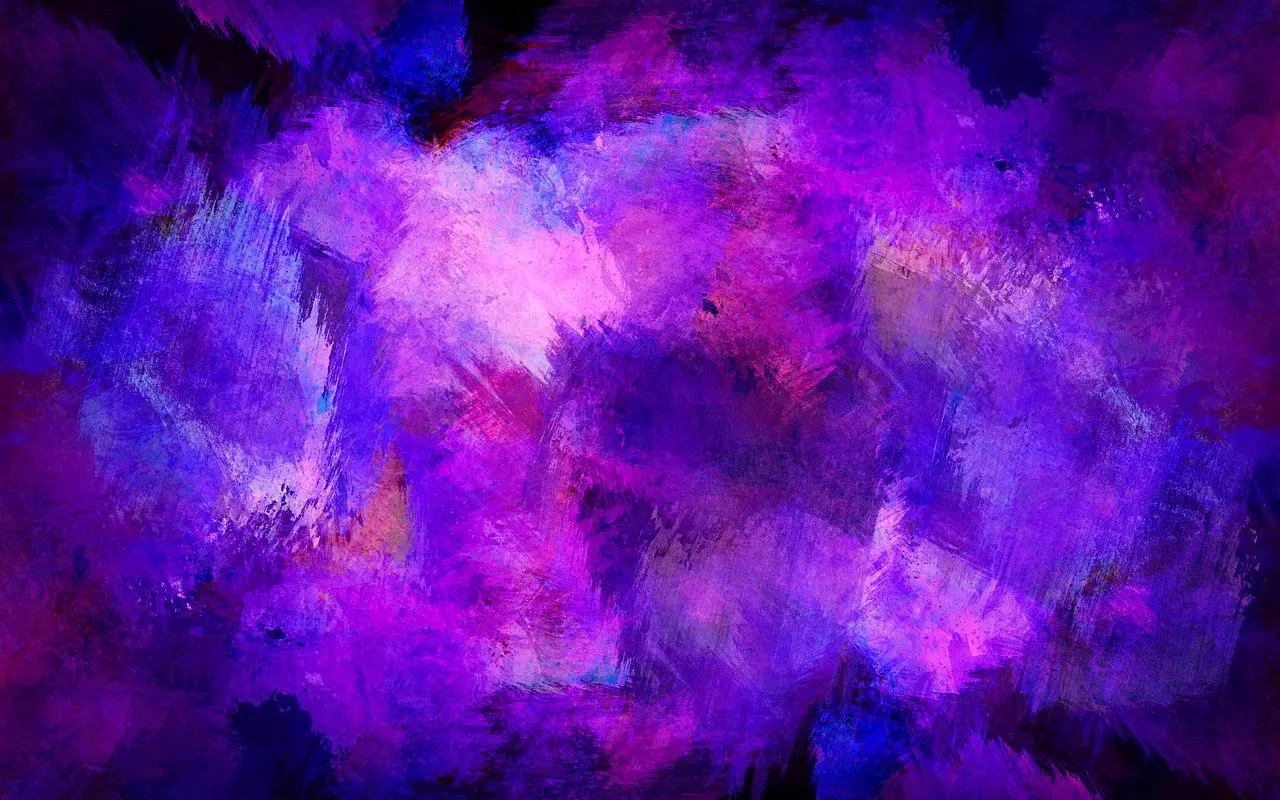Violet is such a beautiful color in nature. It is especially loved by the floral artists. So, you might wonder what colors make violet and how to mix it.
The colors that make a vibrant and saturated violet are quinacridone magenta and ultramarine blue in a 2:1 ratio. Mix with titanium white to change the value of the mixed color. Mixing reds instead of magenta will yield muddy violet colors.
Knowing what pigments or colors to mix to get to the color you want is important. The easiest way to do that is by using the artist’s color wheel with a map of pigments.
What colors do you mix to make violet?
The colors I mix to make violets are magenta and ultramarine blue. As violet is more biased towards blue you will need to mix a little magenta, but more than blue of course. The best ratio to mix violet is a magenta to the ultramarine blue ratio of 2:1. The best choice for a magenta color would be quinacridone magenta.
You can mix a little titanium white to adjust the value of the color. I used the Golden color mixer to mix the violet colors. Below is my results.
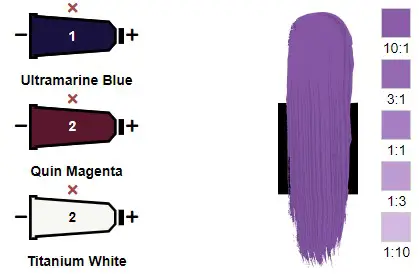
As you can see violet has a blue color bias. Therefore you do not need to mix in more magenta to make it more reddish. You can mix a little titanium white to increase the value of the violet color.
Both quinacridone magenta and ultramarine blue are very useful colors to have. Ultramarine blue is a blue color with a red bias. So it is best to mix purple colors but not so good to mix green colors.
Generally, it says to combine blue and red to mix purple or violet color. But you must use the right blue and red to mix violet or purple. Otherwise, you will end up with a muddy violet color.
When you want to mix a vibrant and saturated color, always look at the undertone or the bias of the color. As an example, ultramarine blue has a red undertone or red bias to it. Now make sure you do not mix complementary colors unless you want a muted color.
So the complementary color of violet is yellow. Make sure you do not introduce yellow into the mix. As an example cadmium red has a yellow undertone to it. If you mix cadmium red to make violet, it will only make a muddy violet or a purple color.
When you are mixing a magenta and ultramarine blue, there is no yellow introduced to the mix. Ultramarine blue has a red undertone. Quinacridone magenta has a blue bias or a cool color. So it is perfect to mix vibrant and saturated violet colors. None of these two colors have a yellow undertone to them.
Violet color in the screens and printing…
Below is the violet color we see on the screens and may be in prints as well. It’s Hex code is #8F00FF. As you can see this violet color is very saturated and intense. This color is harder to mix to this intensity with paint.
Violet #8F00FF
Yet your best bet for mixing a vibrant and vivid violet color is ultramarine blue and magenta. However, your next best choice is to buy a violet color itself. This does not involve any color mixing. Below I have included a violet color from Golden heavy body acrylic paint.
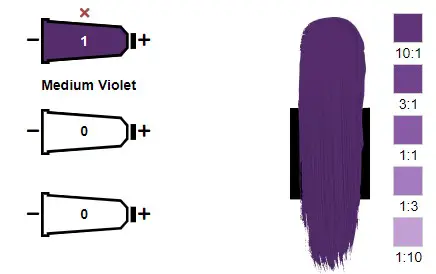
As you can see that violet color itself is not vibrant as the violet color you see on the screen. However, in painting and nature, you will not find a vibrant violet color like on screens. So the color you mix with ultramarine blue and magenta is perfect for a vibrant violet color that you see in nature.
How do you know what colors to mix to get a violet color?
You might wonder how I know what colors to exactly mix to get a violet color. One of the easiest ways to find this is by using the artist’s color wheel by Bruce Mac Evoy. In his color wheel, there is a map of different pigments.
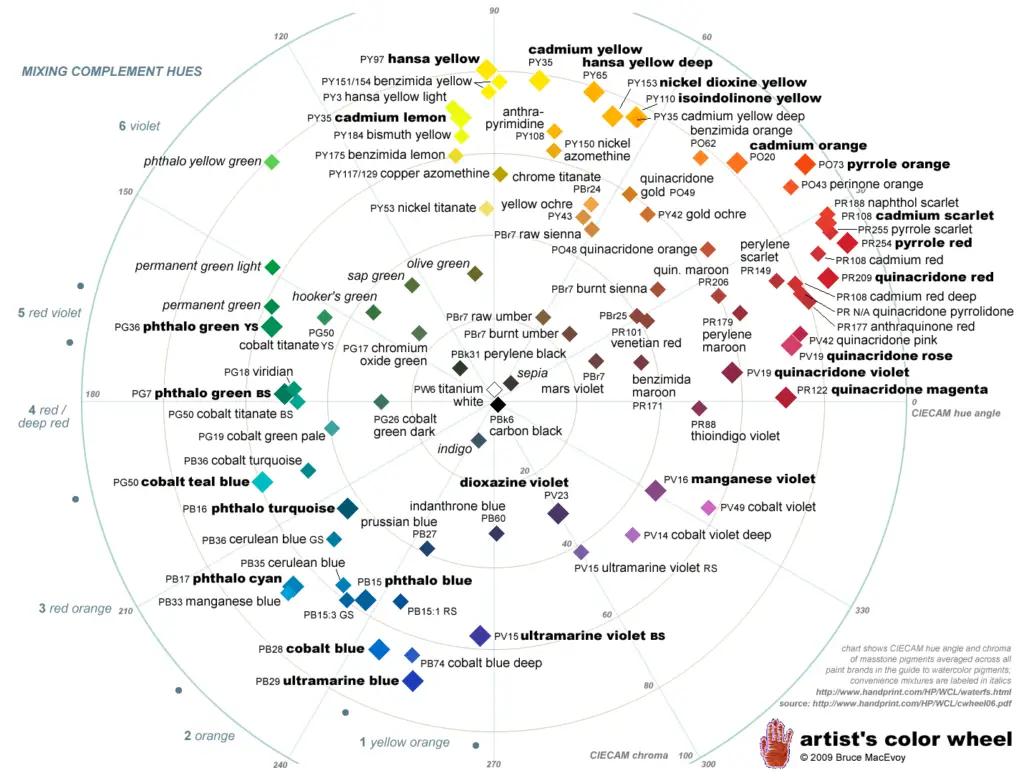
Now what we want to mix is a violet color like manganese violet or violet color in that range. Violet is made by mixing blue and red generally. So, look at the red and blue colors closest to the violet color. Connect them with a line and see what colors the line falls into.
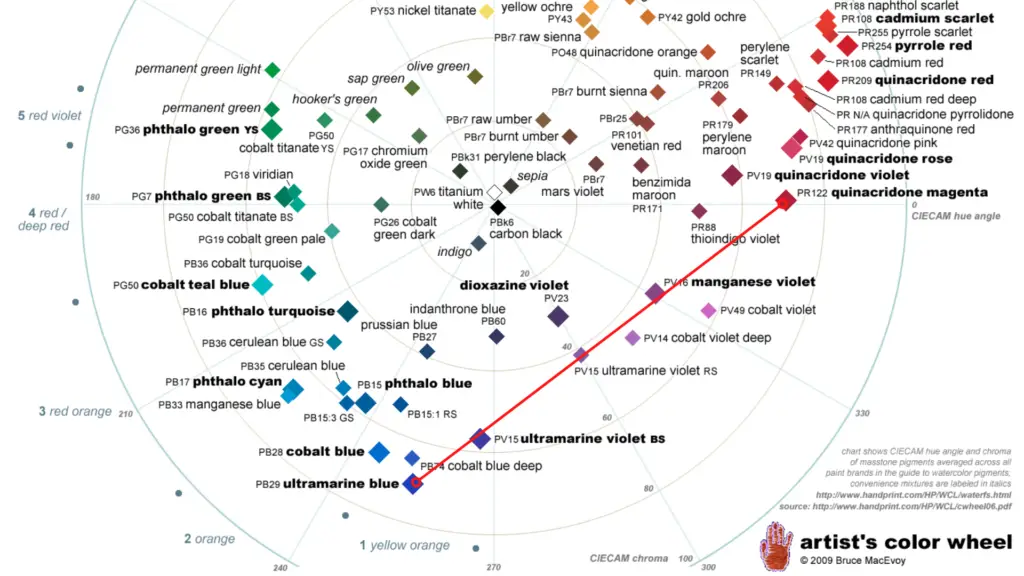
You can draw a line from ultramarine blue to quinacridone magenta. As you can see these are the closest blues and reds to the violet colors in the color wheel. You can see the line goes on top of manganese violet and other violet colors.
The violet color is leaning more towards magenta, meaning you will need to mix more magenta to get the violet color. So I used the Golden color mixer to see what kind of violet color I will get with quinacridone magenta and ultramarine blue. You can see that in the image above.
It is the most vibrant and saturated violet color you can get. As said before never use a red color with a yellow color bias such as cadmium red, as it is complementary to violet color. You can find these warm colors with a yellow bias closest to the yellow pigments on the color wheel.
I have written a whole article about making magenta color. You will find a detailed explanation about magenta and where it fits in our color palettes.
What colors make blue-violet?
The hex code of blue-violet is #8a2be2. It is a more muted shade of violet color. Yet it is a very strong color that will not need to be muted when mixing with paint. You can still mix this color with just ultramarine blue and quinacridone magenta.
Blue-Violet #8a2be2
Now there is also a flower called a blue violet. If you are asking how to mix the color of the blue-violet, here is how to do that. Below I have included an image of a blue-violet flower.
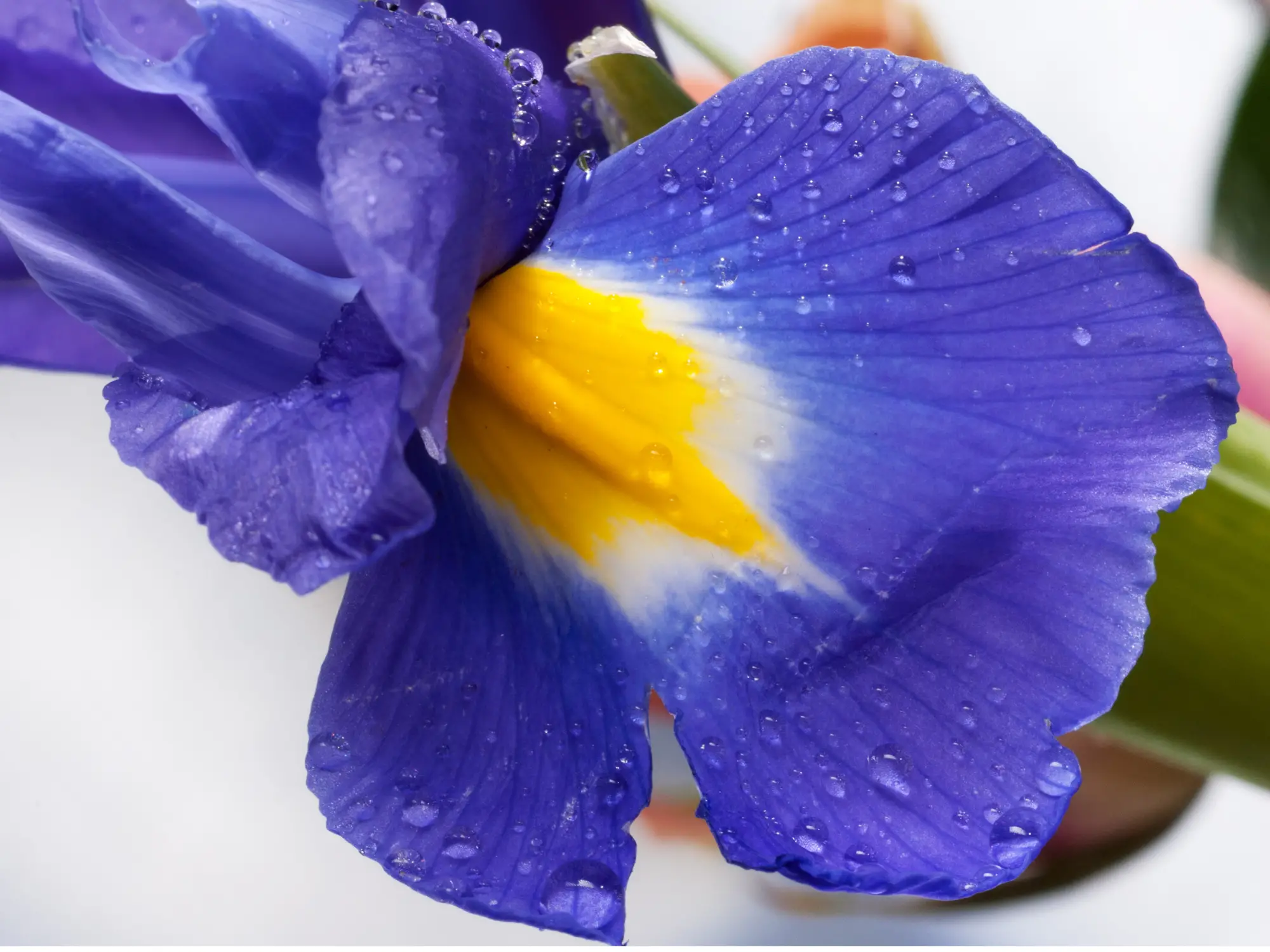
In a blue-violet flower, the violet color is more biased to the blue side and we will need to mix more blue into the color. Let’s see what is the closest violet color pigment to this blue-violet color in the color wheel. Ultramarine violet is the closest pigment to this blue-violet color.
You can use the same mixture of ultramarine blue and quinacridone magenta to mix blue-violet color because the line between ultramarine blue and magenta on the color wheel falls on ultramarine violet. The only thing is that you need to mix more ultramarine blue than magenta.
Blue-violet can be mixed with a 1: 3 ratio of magenta to ultramarine blue. You can adjust the value by mixing it with a little titanium white. Below is the blue-violet color I have mixed using the Golden color mixer.
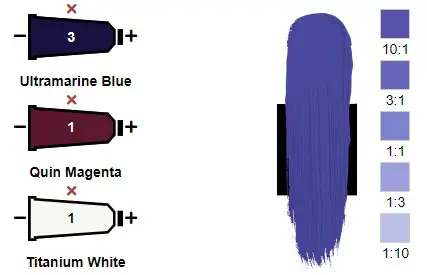
You can also use ultramarine violet itself if you have one. This will be the best choice if you want an accurate and true violet color. You will need to mix a little ultramarine blue with ultramarine violet to get the blue-violet.
What colors make red-violet?
Red violet or #C71585 is a violet that is more biased towards magenta. So clearly you can mix red-violet with the same ultramarine blue and quinacridone magenta. This time you will need more magenta than you mixed for the violet color.
Red violet #C71585
You can use quinacridone magenta as the red-violet color itself. Magenta already has a blue undertone or a blue color bias. So you will not need ultramarine blue to make the red-violet color. Just use the quinacridone magenta. You can mix a little ultramarine blue to get that to the blue side if necessary.
Below you can see the quinacridone magenta from Golden heavy body acrylic paints that match with red-violet color.
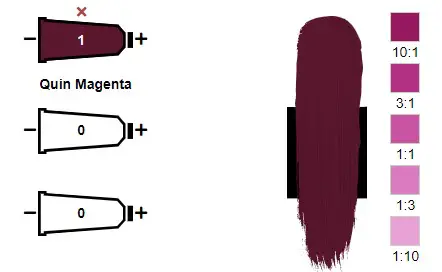
Quinacridone magenta is a useful color to mix vibrant purple and violet colors. So having it in your color palette is a great choice.
How do you make light violet color?
The hex code of light violet color is #CF9FFF. Simply you can make the light violet color by adding titanium white to the violet color you mixed. Use ultramarine blue and quinacridone magenta in a 1:2 ratio to make the violet color.
Light violet #CF9FFF
I have made the light violet color with the golden color mixer using ultramarine blue, quinacridone magenta, and titanium white in a 1:5:12 ratio. You can adjust the value (lightness or darkness of the color by mixing it with titanium white in different ratios.
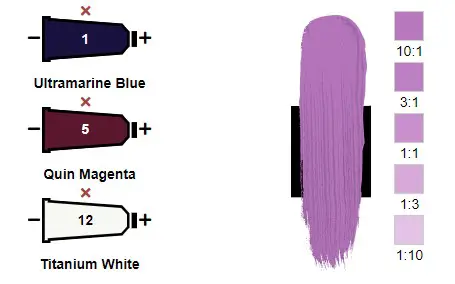
Mixing violet with different mediums
There are different art mediums in the world. Some of them are acrylic, oil, gouache, and watercolors. Most of the time all of these art mediums use the same pigments. So the color mixing process is almost the same, but the effect you get from each medium will be different as each art medium is unique.
How to make violet color with acrylic paint?
In general mix ultramarine blue and quinacridone acrylic colors in a 1:2 ratio to make violet. Then adjust the value (lightness or darkness) by mixing it with titanium white acrylic color. Make sure to use only artist-grade acrylic paint when color mixing for the best results.
Below is the violet color made with Golden heavy body acrylics using the Golden color mixer.

How to make violet color with watercolors?
In general to mix the violet color with watercolors mix ultramarine blue and quinacridone magenta in a 1:2 ratio and then use water to thin the paint and get the violet color.
You can mix oil and gouache paints to make the violet color with the same pigments magenta and ultramarine blue.
What colors make purple?
When we are talking about violet color, we cannot ignore purple. We perceive purple as a more reddish and saturated mixture of red and blue while violet is a more bluish desaturated mixture of red and blue. So what colors make purple?
To mix purple colors combine ultramarine blue, magenta, and titanium white in a ratio of 1:15:3. You can use a dash of phthalo blue instead of ultramarine blue as well. Purple can be made as a shade of magenta, by mixing a dash of black with magenta color.
Purple #800080
I have mixed purple with the Golden color mixer using quinacridone magenta, ultramarine blue, and titanium white. Below is an image of my results.
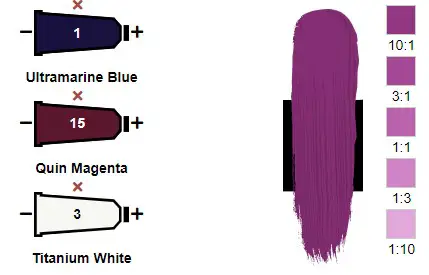
As you can see purple has more magenta in it. By adding a little blue we can push magenta to the purple side of the color wheel.
Purple vs. Violet
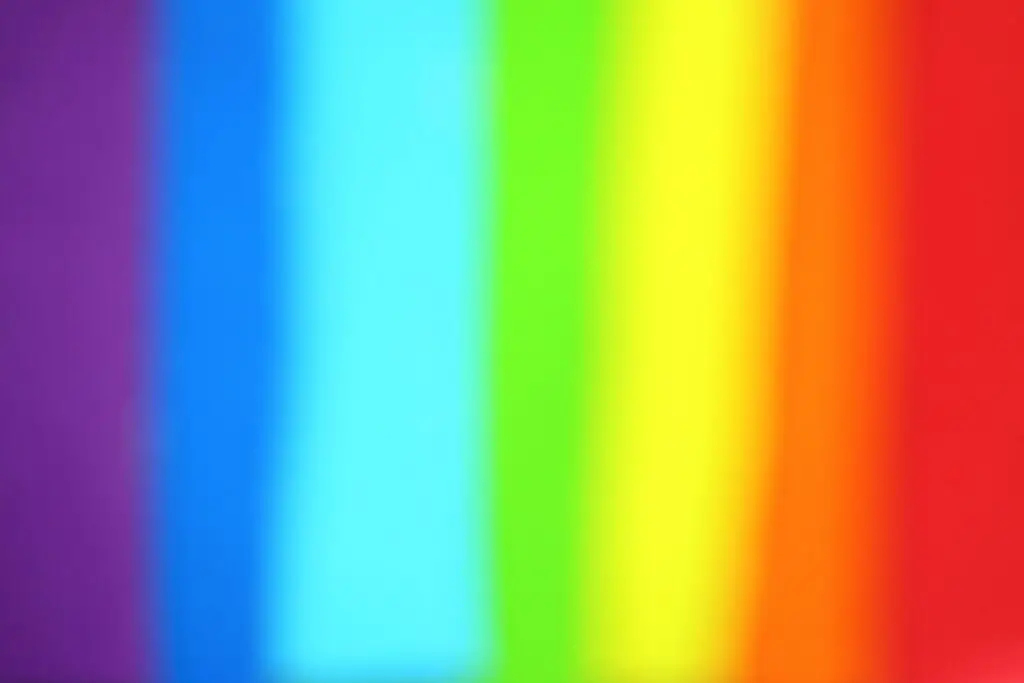
The human eye can only see the colors in the visible light spectrum. So all the colors that we see, which are in the visible light spectrum are true colors. All the other colors that we see are made up by our brain.
As an example, there is no purple or magenta color in the visible light spectrum. But still, we see these colors. However, you can see there is violet in the light spectrum. So violet is a true color. Purple is a color made by our brain. We see purple color when there is red and blue at the same time.
Violet has a true wavelength between 380–450 nm in the color spectrum. But purple is not in the visible color spectrum and does not have a wavelength because it is a color perceived by our brain.
So we can see purple only when we mix red and blue. But violet is just violet. It is not a mixed color but a single pure color by itself. Purple is a mixed color.
However, the screens and printers cannot make the violet color. Therefore they use magenta or red in screens and printing. Then they mix magenta or red with blue to create a violet color. This is the same thing we did when mixing ultramarine blue with quinacridone magenta to make violet.
However, if you want a true and pure violet color, you will have to buy a violet color like ultramarine violet, cobalt violet, Dioxazine violet, etc.
So my advice is if you want a true violet color, do not try to mix it. Rather try to use a true violet pigment like Dioxazine violet as it is a true violet color with high tinting strength.
I have written a whole article explaining the difference between purple and violet colors. You will also learn a lot about color vision in simple terms there.
Conclusion
Violet is a beautiful and pure color in nature. However, we can make violet colors by mixing two other colors. These colors are ultramarine blue and quinacridone magenta. By mixing blue and magenta you can create a vibrant and saturated violet color. Mix with titanium white to adjust the value of the color.
I have written a whole article about acrylic paint color mixing charts. You can learn a lot about mixing all the primary and secondary colors there. There is a free downloadable color mixing chart and a grid as well.

